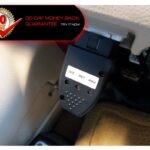In today’s technologically advanced vehicles, understanding the intricate systems under the hood can seem daunting. Modern cars are essentially computers on wheels, relying on complex networks to operate efficiently. Among these networks, two terms frequently arise when discussing vehicle diagnostics: CAN and OBD2. But what exactly is the “Can Obd2 Meaning,” and how do these systems work together to keep your car running smoothly?
To grasp the concept, let’s first break down the individual components and then explore their combined significance in automotive diagnostics.
What is a Bus System in Automotive?
Imagine trying to communicate across a large office building without an internal phone system. You’d need a separate wire for every message you want to send to each person – a chaotic and inefficient setup. Similarly, early cars faced a wiring complexity issue. Each sensor, control unit, and actuator required dedicated wires, leading to bulky, heavy, and costly wiring harnesses.
To simplify communication, engineers developed bus systems. Think of a bus system as a shared communication highway within your car. Instead of numerous individual wires, a bus system uses fewer wires to transmit data between multiple electronic control units (ECUs), sensors, and devices. This significantly reduces wiring complexity, weight, and cost, while improving reliability and facilitating data sharing across the vehicle.
Alt text: Diagram illustrating a simplified bus system in a car, showing multiple components connected to a shared communication line.
Understanding CAN (Controller Area Network)
Within the realm of automotive bus systems, CAN, or Controller Area Network, stands out as the most prevalent and crucial. CAN is a robust and efficient communication protocol specifically designed for vehicles. It allows different microcontrollers and devices to communicate with each other in applications without a host computer.
Think of CAN as the language spoken on the automotive communication highway. It’s a standardized protocol that dictates how data is transmitted, prioritized, and error-checked within the vehicle’s network. CAN is renowned for its reliability in harsh automotive environments, its ability to prioritize critical messages, and its cost-effectiveness. It uses just two wires to transmit data, often referred to as CAN High and CAN Low.
You can delve deeper into the technical aspects of CAN bus on Wikipedia.
OBD-II: The Diagnostic Language
Now, let’s introduce OBD-II, or On-Board Diagnostics II. OBD-II is not a bus system itself but rather a higher-level protocol and standard. It’s essentially a standardized “language” for vehicle diagnostics. OBD-II was mandated in most countries to provide technicians and vehicle owners with access to vehicle health information, emission control data, and diagnostic trouble codes (DTCs).
Imagine OBD-II as the diagnostic manual and tools for understanding your car’s health. It specifies the type of diagnostic information that should be available, how it should be formatted, and how it can be accessed. This standardization allows any compliant OBD-II scanner to communicate with any OBD-II compliant vehicle, regardless of manufacturer.
Alt text: Image showing the typical location of an OBD-II port beneath a car’s dashboard, accessible to the driver.
CAN OBD2 Meaning: The Connection
So, what is the “can obd2 meaning”? The connection lies in the fact that CAN is one of the primary communication networks used to implement the OBD-II protocol in modern vehicles. While OBD-II is the diagnostic language, CAN often serves as the communication channel – the “telephone line” – through which diagnostic data is transmitted.
When you plug an OBD-II scanner into your car’s OBD-II port, it’s often communicating over a CAN bus network. The scanner sends requests using the OBD-II protocol, and the vehicle’s ECUs respond with diagnostic information, also using the OBD-II protocol, transmitted back through the CAN bus.
Therefore, “CAN OBD2 meaning” signifies the utilization of the CAN bus system as the physical layer for transmitting OBD-II diagnostic data. It implies that your vehicle uses CAN to communicate diagnostic information according to the standardized OBD-II protocol.
Using an OBD-II Scanner on a CAN-Equipped Vehicle
Using an OBD-II scanner on a vehicle with a CAN bus system is straightforward. Locate the OBD-II port in your vehicle, which is typically found within reach of the driver, often under the dashboard or in the center console. Consult your vehicle’s manual if you’re unsure of its exact location.
Simply plug your OBD-II scanner into the port. Most modern OBD-II scanners are designed to automatically detect and communicate using CAN and other common OBD-II protocols. Once connected, the scanner can request and display a wealth of diagnostic information, including:
- Diagnostic Trouble Codes (DTCs): Error codes that pinpoint specific issues within the vehicle’s systems.
- Live Data Streams: Real-time sensor readings, such as engine temperature, RPM, and oxygen sensor values.
- Freeze Frame Data: Snapshots of sensor data captured when a DTC was triggered.
- Vehicle Information: VIN, calibration IDs, and other identifying information.
By understanding “can obd2 meaning,” you can appreciate the sophisticated communication network that empowers modern vehicle diagnostics. This knowledge empowers car owners and technicians to effectively diagnose and address vehicle issues, ensuring optimal performance and longevity.

